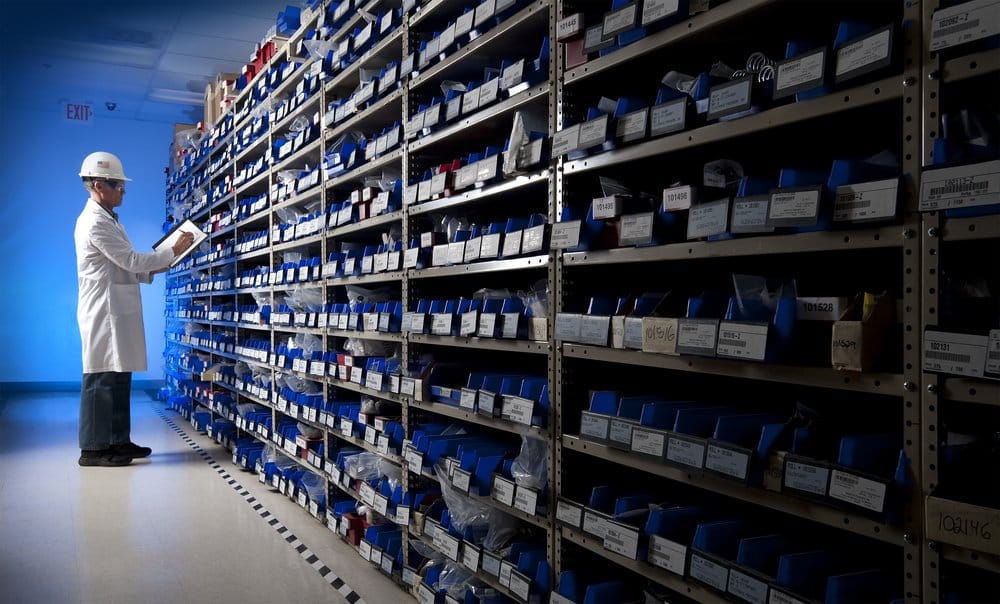Part rooms can quickly become cluttered and disorganized, causing issues with getting, returning, and finding parts. They are notoriously hard to manage because the need for parts room organization is obvious, and the cost of error can be too high. That’s why organizing parts inventory is so important.
Inventory management is a vital part of any manufacturing process, and it is a big challenge even for production lines that have the resources. To make organizing parts inventory work more effectively, you need to develop a strategy that will allow your team to keep track of parts inventory in a way that works best for your company.
5 Benefits of a Properly Organized Parts Warehouse
 Organizing parts inventory has several advantages for multiple companies and individual business owners. We have highlighted some of the most important benefits you can expect if you organize your parts list.
Organizing parts inventory has several advantages for multiple companies and individual business owners. We have highlighted some of the most important benefits you can expect if you organize your parts list.
Increases Productivity
One of the most significant benefits of having a good parts inventory is a boost in productivity. More accurate records mean more precise production, which translates into increased efficiency and higher profits when you have effective organizing parts inventory.
An organized parts warehouse makes it easier for employees to understand the system and focus on organizing parts inventory. Employees can quickly find what they need and know exactly where to go when they need help or don’t understand something when working on organizing parts inventory.
Safety
Another essential factor to consider when talking about parts inventory management is safety. Organized parts can help prevent injuries and improve safety in your facility. A cluttered parts room can make it harder to access the right parts and equipment needed to complete a job.
This variety can be a significant safety hazard, especially when accessing hazardous chemical materials or handling fragile parts. Effective organizing parts inventory management can improve safety. bnm
Better records of parts in circulation will help you reduce the risk of accidents. Each part has a designated space and its last known location with an organized system. This way, each component is safely stored and well-protected.
Optimizes Available Space
A disorganized parts room minimizes the impact of the space that is available. You will have no system to search through several containers and bins to get the correct part with poor organizing parts inventory.
By organizing parts inventory, all your items are categorized by type and purpose, making it easy to keep track of everything. Organized parts will make it easier for your employees to get to the boxes they need without stepping on other items or squeezing through narrow gaps between boxes.
Having the right inventory system also means that your operation will use less space to stock the same amount of parts. This approach will allow you to open new opportunities for procuring more parts or expanding your facility. So, proper systems when organizing parts inventory saves both time and space.
A Professional Impression
The supply chain industry is very image-conscious, even when it comes to organizing parts inventory. You will want to demonstrate a commitment to a professional appearance in everything you do.
An organized parts room is integral to project a sense of professionalism. Organized parts inventory will give you the impression that you are running a more efficient and profitable operation. This approach to organizing parts inventory will help you attract new business, which can help you improve your sales numbers and increase profits in your company.
Enhances the Company Bottom Line
In business, time is precious, especially when organizing parts inventory. Each minute spent searching for a part, transporting to another location, or returning it to the original site represents a form of lost time that you could have used for more critical activities.
A disorganized parts room can also result in additional costs. Errors arising from poorly organizing the parts room can cause production delays, costing your company even more money.
An adequately organized parts room will help you avoid these complications and ensure that your company collects as much profit as possible. Organized parts are much easier to locate and keep track of.
Fewer errors and less re-stocking mean fewer costs for your company. The time savings you get from having organized parts will also allow your business to start recovering costs quickly, leading to bigger paydays in the long run.
3 Signs of a Poorly Optimized Parts Warehouse
A proper evaluation of your parts warehouse quality will help you improve the effectiveness of your inventory management system when organizing parts inventory. Here are the three signs to look for that will tell if your warehouse needs reconfiguration and new parts room organization:
Inability to Find the Products You Need When You Need Them
Inventory management is about providing parts when needed, whether on the assembly line or in the unpredictable experience of a customer support call. That’s why organizing parts inventory is crucial to maintain workflow, especially concerning parts room organization.
A cluttered warehouse will likely have problems handling and storing products. A system that is not optimized enough to find parts when needed can impact your ability to get them to the right place at the right time. Your company’s schedule may be affected, slowing your production cycle.
Long Order Fulfillment Lead Times
Today’s customers expect a fast and seamless experience from when they put in order until it arrives. You can only achieve this when your inventory management system is working correctly.
You’ll likely notice long order fulfillment lead times with a disorganized parts warehouse. Erroneous product tracking and the inability to find items can delay the fulfillment of orders, letting customers down and affecting your brand, all thanks to disorderly organizing parts inventory.
Overstock of Obsolete Parts
Failing to forecast demand accurately is a common problem for inventory management teams. When parts room organization is not up to scratch, you may see an increase in obsolete parts in stock.
Obsolete parts have to be written down or written off and liquidated. It is a highly costly process for you and involves paying for the disposal of products your business can no longer use all because of poor organizing parts inventory.
How to Optimize Your Parts Warehouse to Improve Inventory Management
Your parts warehouse is a critical component of your business’ success. However, optimizing this warehouse can be a challenge. We highlight some of the best organizing parts inventory tips.
Store Parts in Boxes/Bins
Bins and boxes to store parts are easy and efficient, require little storage space, and are easy to organize when focusing on parts room organization. For example, hopper bins prevent clutter, encourage employees to use different materials for storing, and make them easier to retrieve when needed.
Corrugated plastic totes are lightweight and easy to use and can effortlessly integrate with other parts inventory management systems for effective organizing parts inventory.
Index by Manufacturer
An excellent way to organize inventory is by the manufacturer. This approach works exceptionally well for companies with multiple vendor locations, as you can pair each area with the corresponding manufacturer and the appropriate products. Creating multiple separate product listings allows you to track each item’s stock levels more accurately.
Utilize Vertical Space
You should use every inch, and the best way to maximize vertical space is by finding suitable shelving for your products. A high warehouse allows you to maximize your potential and increase the amount of inventory you can store.
Implement a Bin Labeling System
A labeling system is crucial to proper inventory control. You must communicate the parts you store and their availability to your clientele. One way to achieve this is by incorporating a barcode system.
There are many systems out there. However, most warehouse managers choose barcodes over radio frequency identification (RFID) technology because of their low cost and ease of use.
Provide Excellent Lighting
The amount of light in a warehouse impacts the quality and accuracy of your parts inventory management. There is a direct relationship between lighting and visibility. Generally, less light means more shadows meaning the darker the space, the harder it is to see clearly.
Lighting creates a safer atmosphere and makes it easier to see your inventory. You can maximize visibility and your warehouse’s productivity using the proper lighting.
Keep Bulky Items Close to the Ground
Keeping bulky items close to the ground is essential, making them easier to retrieve. Placing these items close to the floor helps create a safer environment for your employees. It minimizes the risk of sprains or back injuries.
Develop Clear, Detailed Naming Conventions
Your inventory system should be easy to understand and easy to navigate. Creating a parts inventory system based on commonly accepted conventions is an excellent way to help your employees understand the procedure.
Conventions such as color coding, abbreviations, and alphabetizing are all methods that can help improve employee productivity. A clear and precise naming system can also help reduce errors and inventory losses.
Keep Fast Moving Parts Available
Moving back and forth or between locations to retrieve parts can waste valuable time. If your warehouse is large and requires employees to move around, keep the fastest-moving products in easy-to-reach places.
This approach helps reduce time spent looking for parts and provides an efficient system to help your employees.
Utilize Inventory Management Software
You can use parts inventory management software to help improve your business. This software can help you organize stocks and track inventory usage, reducing the risk of overstocks or understocks.
These programs can help you streamline activities, save time and money, and reduce the amount of labor your employees need to perform.
Get Organized With MDI Today!

Optimizing your parts warehouse requires comprehensive analysis of how your company focuses on organizing parts inventory. When implemented correctly, there are many ways you can make your parts warehouse more efficient. By following these key strategies, you can minimize the amount of labor your employees need to perform.
Contact MDI today to learn how we can help you organize your parts inventory.